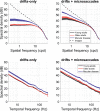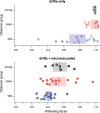Exploration of the functional consequences of fixational eye movements in the absence of a fovea
- PMID: 32106298
- PMCID: PMC7343529
- DOI: 10.1167/jov.20.2.12
Exploration of the functional consequences of fixational eye movements in the absence of a fovea
Abstract
A recent theory posits that ocular drifts of fixational eye movements serve to reformat the visual input of natural images, so that the power of the input image is equalized across a range of spatial frequencies. This "spectral whitening" effect is postulated to improve the processing of high-spatial-frequency information and requires normal fixational eye movements. Given that people with macular disease exhibit abnormal fixational eye movements, do they also exhibit spectral whitening? To answer this question, we computed the power spectral density of movies of natural images translated in space and time according to the fixational eye movements (thus simulating the retinal input) of a group of observers with long-standing bilateral macular disease. Just as for people with normal vision, the power of the retinal input at low spatial frequencies was lower than that based on the 1/f2 relationship, demonstrating spectral whitening. However, the amount of whitening was much less for observers with macular disease when compared with age-matched controls with normal vision. A mediation analysis showed that the eccentricity of the preferred retinal locus adopted by these observers and the characteristics of ocular drifts are important factors limiting the amount of whitening. Finally, we did not find a normal aging effect on spectral whitening. Although these findings alone cannot form a causal link between macular disease and spectral properties of eye movements, they suggest novel potential means of modifying the characteristics of fixational eye movements, which may in turn improve functional vision for people with macular disease.
Conflict of interest statement
Commercial relationships: none.
Figures







References
-
- Barlow H. B. (1961). Possible principles underlying the transformations of sensory messages. In Rosenblith W. A. (Ed.), Sensory communication (pp. 217–234). Cambridge, MA: MIT Press.
-
- Burton G. J., & Moorhead I. R. (1987). Color and spatial structure in natural scenes. Applied Optics, 26(1), 157–170. - PubMed
Publication types
MeSH terms
Grants and funding
LinkOut - more resources
Full Text Sources
Medical
Miscellaneous

